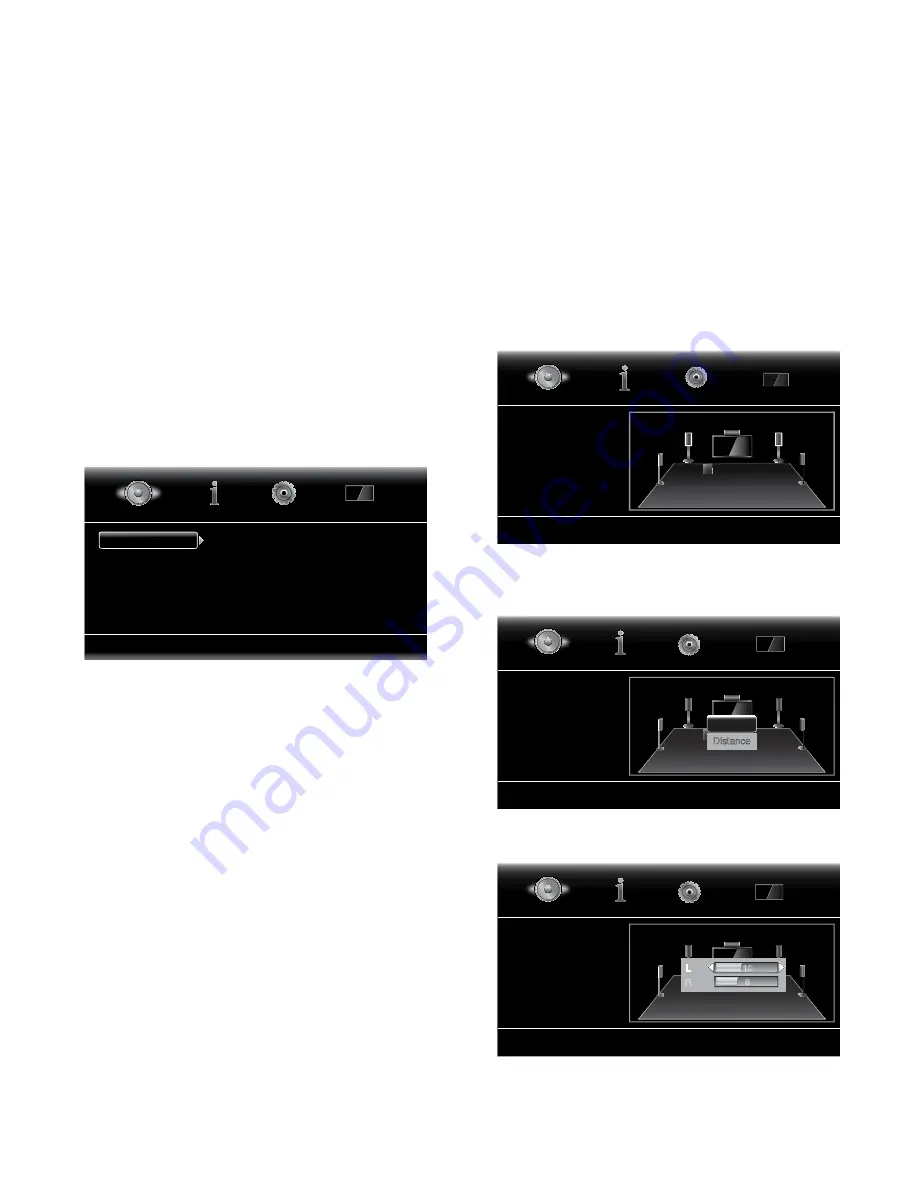
Setting Up the Receiver
21
BDS
HDMI Deep Color:
This option allows you to adjust the resolution of color output to your
TV. If your TV accepts Deep Color, this option allows your TV to display an enhanced
color palette.
s
On: The BDS receiver outputs 36-bit Deep Color if your TV supports it. If your TV does
not, the receiver will output 30-bit color.
s
Off: The BDS receiver does not output Deep Color (color resolution remains at 24 bits).
Video Processing:
This option allows you to set the BDS receiver’s internal video
processing.
Video Mode:
This setting lets you select a preset video-processing option to optimize
the picture for the current program by adjusting the brightness, contrast, color and
sharpness:
s
Standard: Neutral control settings
s
Vivid: For video games
s
Cinema: For movies and many television broadcasts.
s
Custom: This option lets you adjust the picture settings manually. The Brightness,
Saturation (color saturation), Hue, Contrast, Sharpness and CTI settings appear
as sliders. The default setting for each adjustment is 0. Use the Cursor Left/Right
buttons to change each setting’s value.
Audio Settings
Select to adjust Bass & Treble
Tone Controls
Audio Out
Bass
Treble
0dB
0dB
Audio Settings
Tone Controls:
This option lets you increase or decrease the amount of bass (low
frequencies) and treble (high frequencies) in the sound. The adjustment ranges from
–10dB to +10dB, in 1dB increments.
Audio Output:
This option lets you set the following items:
HDMI Audio Out:
In addition to digital video signals, the BDS receiver’s HDMI connection
also carries digital audio signals. Four options are available:
s
Auto: This option causes the receiver’s HDMI output to output the digital-audio
format that best matches the surround-sound decoding capabilities of the
component it’s connected to.
s
Bitstream Native: This option outputs the program in its native audio format via the
HDMI output.
s
PCM: This option outputs a two-channel downmix derived from the program’s native
audio format via the HDMI output.
s
Off: This option turns the receiver’s HDMI audio output off. We recommend setting
this option to “Off,” so you can take full advantage of the superior audio capability
of your BDS system’s receiver and speakers.
Dynamic Range Control:
This setting makes the loud and quiet parts of a movie or music
closer to the same volume (a process known as compression). Compression lets you
turn up the volume so you can hear the quiet parts without the loud parts disturbing
others. NOTE: This feature works only with Dolby Digital programs that have been
specially encoded. Three settings are available:
s
Off: Never applies compression. Use this setting when the volume may be as loud
as you desire.
s
On: Always applies compression. Use this setting when you want the volume to be
as quiet as possible without making it difficult to hear spoken dialogue.
s
Auto: Applies compression based on information encoded in the Dolby Digital
bitstream. The receiver will selectively apply compression only during the most
dynamic parts of the soundtrack.
Speaker Settings:
This setting allows you to set up the receiver to work properly with the
speakers included in your BDS system. The available configurations are:
s
2.0: This configuration consists of left and right main speakers but no subwoofer.
Selecting this configuration sends all of the bass to the left and right speakers, so
be sure that they are full-range and can handle deep bass.
s
2.1: This configuration consists of left and right main speakers, plus a subwoofer.
BDS 400 and BDS 300 systems are factory-set to this configuration.
s
3.1: This configuration consists of front left, center and front right speakers, plus a
subwoofer.
You must manually select this configuration for the BDS 600 system.
s
5.1: This configuration consists of front left, front right, center, surround left and
surround right speakers, plus a subwoofer. BDS 700 and BDS 800 systems are
factory-set to this configuration.
After you select your system’s configuration, the speaker setup screen will appear (BDS
800 and BDS 700 5.1-channel system screen shown):
L (0.0 dB, 3 ft)
R (0.0 dB, 3 ft)
Tone Controls
Audio Out to TV
Speaker Settings
SUB
L
Ls
Rs
R
Center
Audio Settings
Setting the speaker distances:
1. The front left and front right speakers will be highlighted. Press the OK button. The
Level and Distance selection screen will appear.
L (0.0 dB, 3 ft)
R (0.0 dB, 3 ft)
Tone Controls
Audio Out to TV
Speaker Settings
SW1
L
Ls
Rs
R
Center
Audio Settings
Level
Distance
2. Press the Cursor Down button to highlight Distance, and press the OK button. The
Distance adjustment bars will appear.
L (0.0 dB, 10 ft)
R (0.0 dB, 8 ft)
Tone Controls
Audio Out to TV
Speaker Settings
SW1
L
Ls
Rs
R
C
Audio Settings
L
R
10
8
3. Measure the distance from the listening position to each of your system’s speakers,
including the subwoofer. Write down the distances.






























